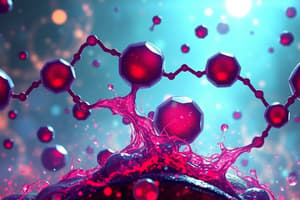Podcast
Questions and Answers
What characterizes heterocyclic compounds?
What characterizes heterocyclic compounds?
- They have at least one non-carbon atom in the ring. (correct)
- They are always large cycle compounds.
- They must have a ring size greater than 9 atoms.
- They contain only carbon atoms in the ring.
What is a defining feature of macrocycle compounds?
What is a defining feature of macrocycle compounds?
- They consist of only a single ring structure.
- They can include rings smaller than 9 atoms.
- They always contain only carbon and oxygen atoms.
- They have a ring size of at least 9 atoms. (correct)
How many donor atoms must be present in a macrocycle compound?
How many donor atoms must be present in a macrocycle compound?
- At least 3 donor atoms. (correct)
- At least 1 donor atom.
- At least 2 donor atoms.
- At least 4 donor atoms.
Which of the following statements is true about cyclic compounds?
Which of the following statements is true about cyclic compounds?
Which term describes compounds with a ring size of at least 9 atoms?
Which term describes compounds with a ring size of at least 9 atoms?
What component forms the heme molecule when combined with a protein?
What component forms the heme molecule when combined with a protein?
How many donor sites for electrons are present in porphyrins?
How many donor sites for electrons are present in porphyrins?
What holds the iron in the center of the heme molecule?
What holds the iron in the center of the heme molecule?
Which structure links the four pyrrole rings in a porphyrin?
Which structure links the four pyrrole rings in a porphyrin?
What type of ions do porphyrins have a high affinity for?
What type of ions do porphyrins have a high affinity for?
What type of enzyme is Porphobilinogen Synthase?
What type of enzyme is Porphobilinogen Synthase?
Which metal is an essential component of Porphobilinogen Synthase?
Which metal is an essential component of Porphobilinogen Synthase?
What effect do heavy metals have on Porphobilinogen Synthase?
What effect do heavy metals have on Porphobilinogen Synthase?
What characteristic makes Porphobilinogen Synthase distinctly vulnerable?
What characteristic makes Porphobilinogen Synthase distinctly vulnerable?
Which of these statements about Porphobilinogen Synthase is true?
Which of these statements about Porphobilinogen Synthase is true?
What can occupy the Zn++ binding sites in mammalian Porphobilinogen Synthase?
What can occupy the Zn++ binding sites in mammalian Porphobilinogen Synthase?
What is the consequence of lead inhibition on Porphobilinogen Synthase?
What is the consequence of lead inhibition on Porphobilinogen Synthase?
What causes Acute Intermittent Porphyria?
What causes Acute Intermittent Porphyria?
What prosthetic group is associated with Porphobilinogen Deaminase?
What prosthetic group is associated with Porphobilinogen Deaminase?
What type of reaction is involved in the transformation that occurs during the activity of Porphobilinogen Synthase?
What type of reaction is involved in the transformation that occurs during the activity of Porphobilinogen Synthase?
Flashcards
Heme
Heme
A molecule with a central iron atom surrounded by a ring of four nitrogen atoms.
Hemoproteins
Hemoproteins
Proteins that contain heme as a prosthetic group.
Porphyrin
Porphyrin
An organic molecule with a specific structure consisting of four pyrrole rings linked by methenyl bridges.
Methenyl bridge
Methenyl bridge
Signup and view all the flashcards
Porphyrins (Donor Sites)
Porphyrins (Donor Sites)
Signup and view all the flashcards
Heterocyclic compounds
Heterocyclic compounds
Signup and view all the flashcards
Macrocycle compounds
Macrocycle compounds
Signup and view all the flashcards
Donor atoms
Donor atoms
Signup and view all the flashcards
Ring size
Ring size
Signup and view all the flashcards
Porphobilinogen Synthase (ALA Dehydratase)
Porphobilinogen Synthase (ALA Dehydratase)
Signup and view all the flashcards
Acute Intermittent Porphyria
Acute Intermittent Porphyria
Signup and view all the flashcards
Porphobilinogen Synthase
Porphobilinogen Synthase
Signup and view all the flashcards
Hydroxymethylbilane
Hydroxymethylbilane
Signup and view all the flashcards
Lead (Pb++)
Lead (Pb++)
Signup and view all the flashcards
Porphobilinogen Deaminase
Porphobilinogen Deaminase
Signup and view all the flashcards
Study Notes
Heme Synthesis
- Heme is a crucial component of hemoglobin and other proteins
- Hemoglobin is the protein in red blood cells that carries oxygen
- The synthesis of heme involves a series of enzymatic reactions
- Key molecules involved in heme synthesis include porphyrins and iron
- Porphyrins are cyclic compounds built from modified pyrrole subunits
- Porphyrins often chelate iron, which is crucial for oxygen transport
- The iron atom is held within the porphyrin ring by bonds to four nitrogens, central to oxygen transport
Porphyrins
- Porphyrins are macrocyclic compounds
- These macrocycles consist of four pyrrole complexes
- These pyrroles are connected through methine bridges
- The core structure of porphyrins is aromatic due to alternating double bonds
- Porphyrins have high affinity for metal ions, including iron
- The different types of porphyrins vary in the nature of the substituents/side chains
- The four most important are Uroporphyrin, Coproporphyrin, and Protoporphyrin IX
Hemoproteins
- Hemoproteins are proteins that contain heme groups
- These proteins play crucial roles in oxygen transfer and electron transfer
- Hemoglobin and myoglobin are examples of hemeproteins involved in oxygen transport
- Cytochromes are hemeproteins involved in electron transport
- Hemeproteins are involved in various biological functions
Porphyrin Metabolism
- Heme proteins are synthesized and degraded constantly
- The average rate of daily synthesis and degradation in humans is 6-7g.
- Hemoglobin turnover is important for body’s function
- The synthesis mainly takes place in the liver and bone marrow
- Erythroid tissue is a key site for hemoglobin synthesis
- Synthesis reactions proceed in mitochondria and cytosol
- The rate-limiting step in heme synthesis is the formation of 8-aminolevulinic acid (ALA)
- ALA synthase is a key enzyme in the process
- The enzyme ALA synthase is sensitive to inhibitors like lead
- Lead poisoning can disrupt heme synthesis
Metalloporphyrins
- Metalloporphyrins are complexes of porphyrins with metals
- These metals include iron, magnesium, and cobalt
- These metals are coordinated at the center of the porphyrin ring
- The metals are important for the functions of chlorophyll, hemoglobin, and vitamin B12
Porphyrinogens
- Porphyrinogens are precursors to porphyrins
- They are formed through several enzymatic steps
- Porphyrin ring structure is formed from the condensation of 4 molecules of porphobilinogen
- Porphobilinogen is catalyzed by porphobilinogen deaminase
- Porphobilinogen deaminase is a zinc-containing enzyme in humans and is inhibited by heavy metals like lead.
Types of Porphyrines
- There are various types of porphyrins in nature
- Some of the important types include uroporphyrin, coproporphyrin, and protoporphyrin IX
- These types differ in the substituent patterns on their rings.
- Type I porphyrins have symmetric side chains
- Type III porphyrins have asymmetric side chains.
Heme Synthesis Stages
- The synthesis of heme involves several enzymatic steps
- Key reactions include oxidative decarboxylation stages.
- These stages are crucial in modifying different molecules involved in the heme synthesis pathway
- Each enzyme catalyzes specific steps.
- Stages occur in mitochondria and cytosol
- The synthesis of heme involves various steps and modifications to intermediates.
Studying That Suits You
Use AI to generate personalized quizzes and flashcards to suit your learning preferences.




